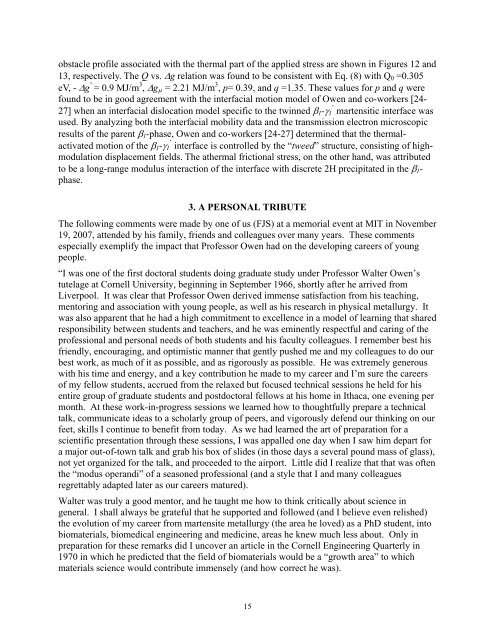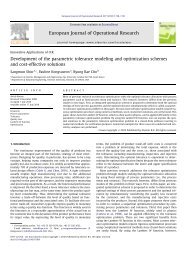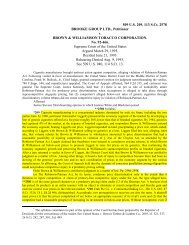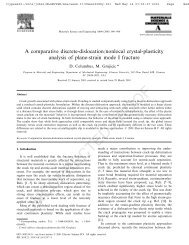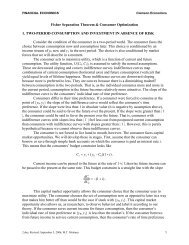a tribute to professor walter shepherd owen - Clemson University
a tribute to professor walter shepherd owen - Clemson University
a tribute to professor walter shepherd owen - Clemson University
You also want an ePaper? Increase the reach of your titles
YUMPU automatically turns print PDFs into web optimized ePapers that Google loves.
obstacle profile associated with the thermal part of the applied stress are shown in Figures 12 and<br />
13, respectively. The Q vs. Δg relation was found <strong>to</strong> be consistent with Eq. (8) with Q0 =0.305<br />
eV, - Δg ^ = 0.9 MJ/m 3 , Δgμ = 2.21 MJ/m 3 , p= 0.39, and q =1.35. These values for p and q were<br />
found <strong>to</strong> be in good agreement with the interfacial motion model of Owen and co-workers [24-<br />
27] when an interfacial dislocation model specific <strong>to</strong> the twinned β1-γ1 ’ martensitic interface was<br />
used. By analyzing both the interfacial mobility data and the transmission electron microscopic<br />
results of the parent β1-phase, Owen and co-workers [24-27] determined that the thermalactivated<br />
motion of the β1-γ1 ’ interface is controlled by the “tweed” structure, consisting of highmodulation<br />
displacement fields. The athermal frictional stress, on the other hand, was at<strong>tribute</strong>d<br />
<strong>to</strong> be a long-range modulus interaction of the interface with discrete 2H precipitated in the β1phase.<br />
3. A PERSONAL TRIBUTE<br />
The following comments were made by one of us (FJS) at a memorial event at MIT in November<br />
19, 2007, attended by his family, friends and colleagues over many years. These comments<br />
especially exemplify the impact that Professor Owen had on the developing careers of young<br />
people.<br />
“I was one of the first doc<strong>to</strong>ral students doing graduate study under Professor Walter Owen’s<br />
tutelage at Cornell <strong>University</strong>, beginning in September 1966, shortly after he arrived from<br />
Liverpool. It was clear that Professor Owen derived immense satisfaction from his teaching,<br />
men<strong>to</strong>ring and association with young people, as well as his research in physical metallurgy. It<br />
was also apparent that he had a high commitment <strong>to</strong> excellence in a model of learning that shared<br />
responsibility between students and teachers, and he was eminently respectful and caring of the<br />
professional and personal needs of both students and his faculty colleagues. I remember best his<br />
friendly, encouraging, and optimistic manner that gently pushed me and my colleagues <strong>to</strong> do our<br />
best work, as much of it as possible, and as rigorously as possible. He was extremely generous<br />
with his time and energy, and a key contribution he made <strong>to</strong> my career and I’m sure the careers<br />
of my fellow students, accrued from the relaxed but focused technical sessions he held for his<br />
entire group of graduate students and postdoc<strong>to</strong>ral fellows at his home in Ithaca, one evening per<br />
month. At these work-in-progress sessions we learned how <strong>to</strong> thoughtfully prepare a technical<br />
talk, communicate ideas <strong>to</strong> a scholarly group of peers, and vigorously defend our thinking on our<br />
feet, skills I continue <strong>to</strong> benefit from <strong>to</strong>day. As we had learned the art of preparation for a<br />
scientific presentation through these sessions, I was appalled one day when I saw him depart for<br />
a major out-of-<strong>to</strong>wn talk and grab his box of slides (in those days a several pound mass of glass),<br />
not yet organized for the talk, and proceeded <strong>to</strong> the airport. Little did I realize that that was often<br />
the “modus operandi” of a seasoned professional (and a style that I and many colleagues<br />
regrettably adapted later as our careers matured).<br />
Walter was truly a good men<strong>to</strong>r, and he taught me how <strong>to</strong> think critically about science in<br />
general. I shall always be grateful that he supported and followed (and I believe even relished)<br />
the evolution of my career from martensite metallurgy (the area he loved) as a PhD student, in<strong>to</strong><br />
biomaterials, biomedical engineering and medicine, areas he knew much less about. Only in<br />
preparation for these remarks did I uncover an article in the Cornell Engineering Quarterly in<br />
1970 in which he predicted that the field of biomaterials would be a “growth area” <strong>to</strong> which<br />
materials science would con<strong>tribute</strong> immensely (and how correct he was).<br />
15


